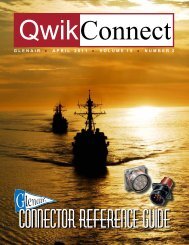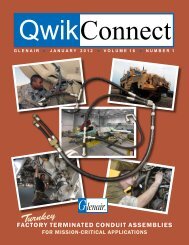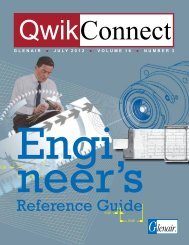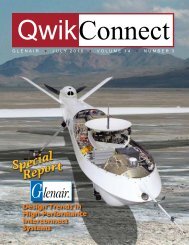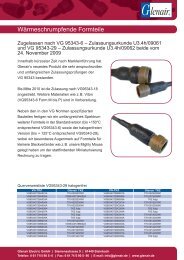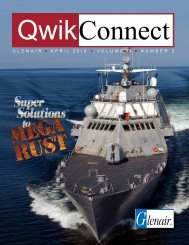RoHS - Glenair UK Ltd
RoHS - Glenair UK Ltd
RoHS - Glenair UK Ltd
You also want an ePaper? Increase the reach of your titles
YUMPU automatically turns print PDFs into web optimized ePapers that Google loves.
Active Versus Noble Metals in<br />
Interconnect Systems<br />
Metal materials used in manufacturing have<br />
different electrochemical potentials. Even socalled<br />
“pure” metals have inherent differences<br />
in electrochemical potential at the microscopic<br />
level. This is why a block of steel sitting all<br />
by itself corrodes. The order in which metals<br />
will corrode is always from the most anodic<br />
(active) to the most cathodic (noble). When<br />
two dissimilar metals are put together, only the<br />
more anodic metal will corrode. The magnitude<br />
of potential difference between the two metals,<br />
and which of the metals has the more negative<br />
potential, will determine which metal will be the<br />
cathode, which will be the anode, and the rate at<br />
which corrosion will occur.<br />
Aluminum, bronze and stainless steel are<br />
all common material choices in interconnect<br />
hardware. Tin-plated copper wire is the most<br />
common material for RFI/EMI shielding,<br />
together with nickel-plated copper and silverplated<br />
copper wire. Cadmium over nickel<br />
plating, the standard “W” finish specification<br />
called out in MIL-C-85409, is by far the most<br />
16<br />
GALVANIC TABLE<br />
GROUP MATERIAL EMF (Volts)<br />
QwikConnect<br />
common metallic surface finish, followed<br />
closely by commercial combinations of zinc,<br />
nickel and copper. It should be readily apparent<br />
that with this broad range of metal types in<br />
use, an interconnect system is a dissimilar<br />
metal accident just waiting to happen. The<br />
dissimilar metal problem is compounded by the<br />
unfortunate porosity of plated surfaces and the<br />
potential for protective plating to be scratched<br />
or damaged in handling. Both situations allow<br />
for electrolytic coupling of the base metal to its<br />
cadmium and nickel plating, which eventually<br />
results in catastrophic corrosion of the base<br />
material.<br />
As mentioned, the obvious solution is to<br />
transition from metal materials to composite. But<br />
for all metal systems, the preferred approach<br />
is to select metal material combinations which<br />
are at least compatible within an index of .25<br />
volts on the galvanic table. When this maximum<br />
is adhered to, the sacrificing of less-noble<br />
metals to more-noble metals is controlled,<br />
and components will survive the 500 hour salt<br />
fog minimum exposure required by military<br />
standards. Please consult the factory for<br />
additional information.<br />
ANODIC<br />
INDEX (.01V)<br />
– Titanium and Cobalt Plate + .10 5<br />
3 Silver Plate 0 15<br />
4 Monel and Nickel Plate .15 30<br />
5 Copper .20 35<br />
7 Bronze and Brass .30 45<br />
8 18-8 SST .35 50<br />
10 Tin Plate .50 65<br />
14 Aluminum .75 90<br />
15 Cadmium Plate .80 95<br />
17 Zinc Plate 1.10 125<br />
COMPATIBLE<br />
COUPLES @ .25V<br />
QwikConnect n January 2009



